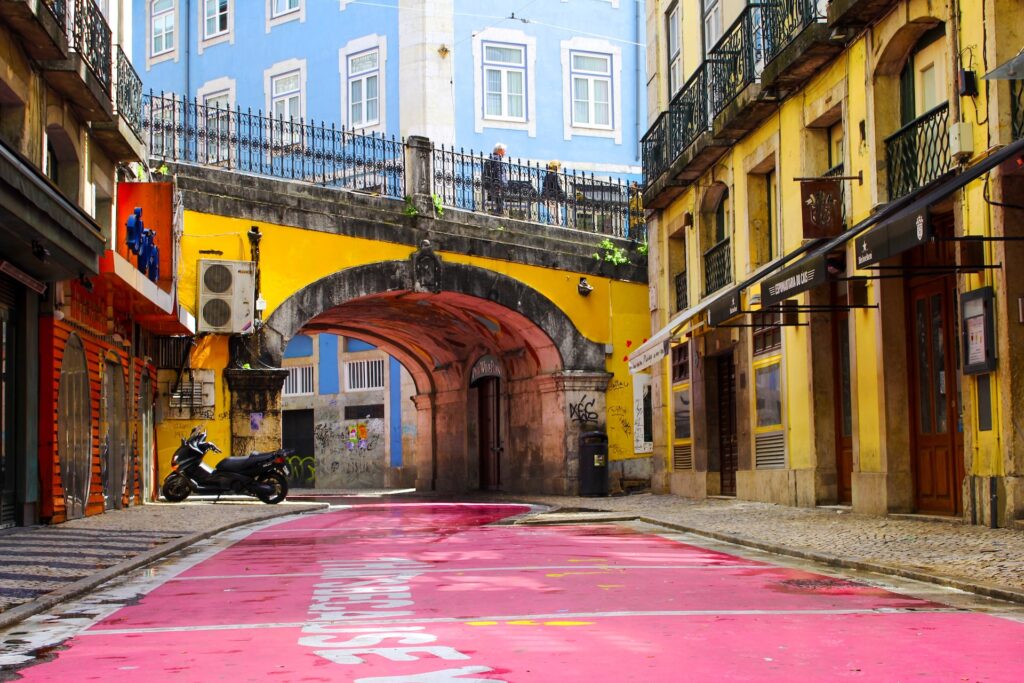
Bairro Alto is one of the most iconic districts in Lisbon, meaning the high neighborhood, it is located on one of the highest hills of Lisbon and it’s full of life during the day and even more during the night. Bairro Alto is the most important area of Lisbon nightlife.
And sharing the same hill, there’s Chiado. A place full of beauty, drama, and disaster, that seems to be stuck in time. Full of vintage shops, restaurants, cafes and history in every corner, Chiado is amazing to wonder about.
With this free walking tour, you will discover all about Bairro Alto and Chiado.
This tour starts in Praça da Figueira and it starts the most traditional way possible, with an elevator ride to Bairro Alto. Doing like this, you will be doing this tour always walking down hill. If you start from the Baixa area, you will be walking uphill.
What you need to know about the history of Lisbon before starting this tour:
We will mention this a lot on this tour, so it is better to know a couple of things. In 1755 there was a huge earthquake that destroyed most of downtown Lisbon, and at that time, because most of the houses had candles lit on and the construction was mostly wood, downtown Lisbon started to burn. A hour later, a tsunami hit Lisbon, because of the earthquake.
So in a day, old downtown Lisbon trembled, burned and then was washed away.
For the reconstruction of downtown LIsbon, modern concepts were used, like building earthquake proof, straight streets, large avenues and identical blocks of buildings.
Tour steps:
Ascensor da Gloria
From Praça dos Restauradores take the Ascensor da Gloria to the top of the hill. These tram cars look alike were built around downtown Lisbon to take people from the lower parts of the city to the higher parts.
If you don’t have a ticket of 24 hours for the public transportations or the Lisboa Card, you will need to pay around 3 euros to go up the elevator.
Miradouro de São Pedro de Alcântara
When you reach the top, turn right and after a few steps you will reach Miradouro de São Pedro de Alcântara, and from here you can enjoy great views over downtown Lisbon.
(Check our walking tour of lisbon baixa) link
Convento de São Pedro de Alcântara
When you’re done enjoying those views, across the street you will see the Convento de São Pedro de Alcântara. From the outside it will not look like a lot, but go inside. No only is it free but in this old convent, you will discover that the walls are decorated with beautiful traditional Portuguese titles. Go inside and wander inside and see how the old nuns lived here.
Bairro Alto
When you are done instead going down through the busy main street, go around the convent to the back street and walk down. You will be descending through the Rua da Rosa.
On this walk, enjoy the old narrow streets of Lisbon, the cobblestone sidewalks and the colorful buildings.
Go until you see a green building at your left with green titles on its facade. Then turn left at the end of this building and walk straight it down, until the next checkpoint:
Sao Roque Church
At the end of the street Travessa da Água da Flor you will find the Sao Roque Church.
Built in the 16th century the Sao Roque church is one of the first Jesuit churches in the world. It was the main Jesuit church in Portugal for more than 200 hundred years until the jesuítas were expelled from Portugal, just before the 18th century.
It was one of the few buildings in Lisbon to escape undamaged in the 1755 earthquake. So as most of the buildings in Lisbon are from the 18th century forward, this is one that still holds the same as it was.
While the face of this church is simple and undecorated, the inside is rich with paintings, tiles and gold carvings.
When inside, take a look at the ceiling to its Italian style frescos.
Sao Roque Museum
When leaving the Sao Roque Church, right on the side of the building you will find the Sao Roque Museum.
First opened to the public in 1898, during the celebrations of the arrival of Vasco da Gama in India, it holds an amazing collection of the most important religious art in Portugal.
Cervejaria Trindade
A bit down the street to your left, there is the Cervejaria Trindade, the oldest brewery in Lisbon, that belongs to the artistic and cultural patrimony of Lisbon on the Rua da Nova Trindade.
Cervejaria means brewery and Trindade means Trinity (from a reference to the Holy Trinity). The name originates from when it was a convent but after 1836,
became a brewery as monastic orders were forbidden in Portugal 1834.
It’s a wonderful place to snack something and try some of the house beer. And when inside, eat and drink were the old dining hall of the monastery and enjoy the amazing title works with centuries old.
It is a unique experience to dine as the ancient nuns did in Lisbon.
Largo do Carmo
As you leave Cervejaria Trindade, turn left on the first street and then take the second right. You will be at Largo do Carmo square and in the Chiado district.
This square was the main stage of the revolution on the 25th of April of 1974 as it was the place of surrender of the dictatorship regime in Portugal.
Across the square of the convent you will see the Palácios Valadares. Here was the first university in Portugal before it was transferred to Coimbra.
This square has been used for filming several movies, documentaries and commercials. It is truly a cinematographic experience to just stand in the middle of this square and observe the surroundings.
Convento do Carmo
Like we said before, most of the buildings in Lisbon were destroyed in the 1755 earthquake and the convent you see on the Largo do Carmo square is the perfect example as Lisbon stood after the earthquake.
Standing proud over Lisbon with no roof and damaged pillars, the Convento do Carmo which was built in 1389, and although the rebuilding started on a small wing, the constructions stopped due to the abolition of the monastic orders in Portugal.
Several plans were developed to rebuild the church, but maybe due to some Romantic tastes, it was decided to keep the church as it is. With the sky as its roof.
Archeological Carmo Museum
On the Convento do Carmo you will find the Archeological Carmo Museum. Although it has a small collection, it is very interesting. From the Paleolithic and Neolithic period, you will enjoy several pieces including several pieces of a prehistoric fortification from north of Lisbon.
Here you will also see several gothic tombs of Portuguese Kings,Roman and Visigoth pieces, and even a couple of Peruvians múmias, just to keep things interesting.
Elevador da Santa Justa viewpoint
When leaving Convento do Carmo, go around the building to find the top part of the Elevador da Santa Justa. An elevator built in 1901 to take people from the downtown part of Lisbon to the hightown, with a height of 45 meters.
Instead of waiting at the bottom, and a fee to go up, just walk on the catwalk and enjoy the same views that the people that do take the elevator up.
But, for spectacular views, on the same catwalk go to the elevator and pay to get to the rooftop only. It is 1,50€, but the views are truly amazing. Enjoy the views of the Baixa, Castle and River.
This is a place for you to take your best pictures.
Cafe a Brasileira
After enjoying the beautiful views from the Elevador da Santa Justa, go back to the Largo do Carmo and across the square, go through the Travessa do Carmo street and turn on third right.
You will reach the Cafe a Brasileira. An old cafe with an Art Nouveau decor, it is one of the most emblematic places to have a coffee.
It opened to the public in 1905 and is now very famous, because in the 1920’s and 30’s it was the hanging spot for writers, poets, painters and other several artists. The most famous one is Fernando Pessoa, a Lisbon writer, who shocked POrtuguese literature, for writing in the name of several fictional writers.
Here order a cup of coffee and a “pastel de nata”, sit close to the Fernando de Pessoa statue on the coffee esplanade and absorb the environment around you, like if you were an artist in the 1930’s.
Rua Garrett
When you are done with your coffee and taking a break, walk down the street. You are in the Rua Garrett street, the Main Street of Chiado. Here you will see many vintage shops that were open for a hundred years and new shops that maintained the original look of former streets. Explore some shops, especially the Bertrand bookstore that opened in 1732 and enjoy the vintage look.
And at the end of the Rua Garrett street, there is the Armazéns do Chiado. An old department store that burned down in one of the most modern fires in the history of Lisbon, in 1988 and remodeled into the most iconic shopping center in downtown Lisbon.
And now that you reached the end of your tour, if you’re getting hungry, you’re near the perfect place. Bairro Alto has so many excellent restaurants and in all price ranges. Enjoy some of the best POrtuguese food in the most traditional district of Lisbon.
Our recommended restaurants:
If you like this self guided tour of Bairro Alto and Chiado, take a look on our other self-guided tours in Lisbon:
Self guided tour of Lisbon trams
Self guided tour of Alfama
Self guided tour of Baixa
